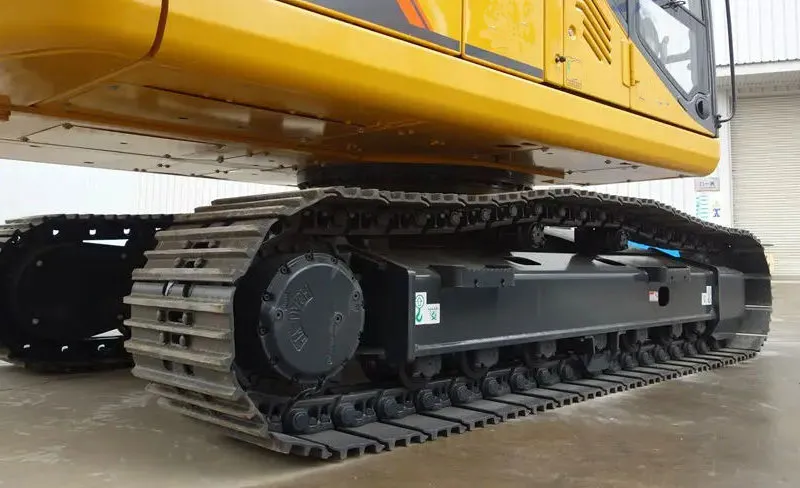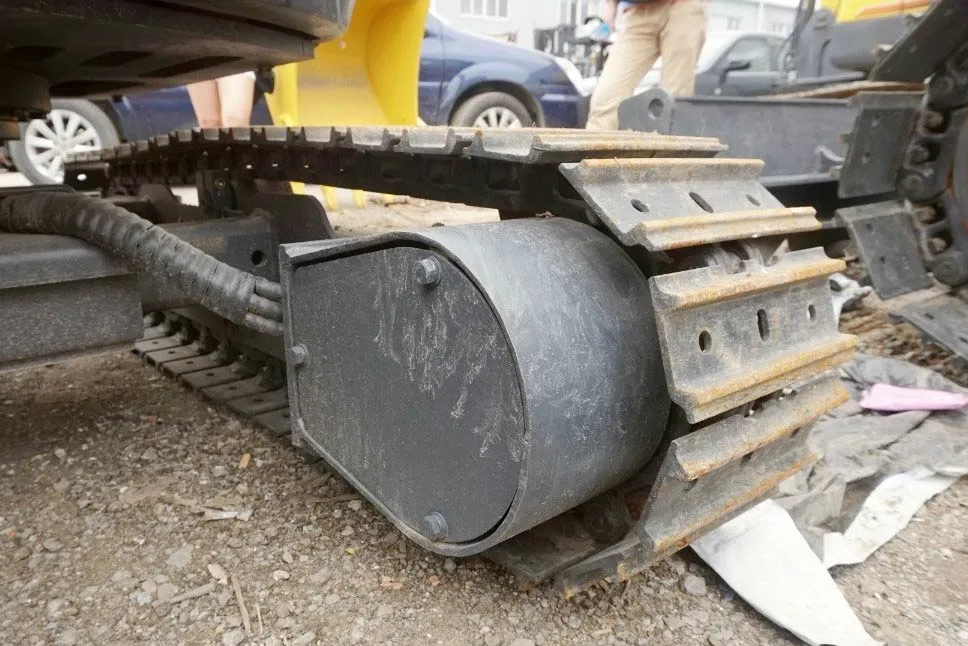
Excavator track frames are a critical component of any excavator, playing a pivotal role in the machine’s stability, mobility, and overall performance. In this comprehensive guide, we will explore the intricacies of excavator track frames, including their design, materials, maintenance, and much more.
Excavator track frames are the structural framework that supports the entire undercarriage of the excavator. They provide the necessary foundation for the tracks to operate efficiently, ensuring the machine can traverse various terrains with ease. These frames are typically constructed from high-strength steel to withstand the extreme conditions and heavy loads encountered during excavation tasks.
The design of track frames is crucial for the optimal performance of the excavator. Engineers meticulously calculate the dimensions, weight distribution, and structural integrity to ensure the frames can handle the stresses and strains of heavy-duty operations. Moreover, track frames often incorporate various components such as track rollers, idlers, and sprockets, all of which contribute to the smooth movement and stability of the excavator.
High-quality excavator track frames are essential for several reasons. Firstly, they significantly enhance the durability and longevity of the excavator. Robust track frames can endure the harshest working conditions, reducing the risk of structural failures and costly downtime. Additionally, well-designed track frames improve the machine’s overall performance, allowing for smoother operation and better maneuverability on uneven terrain.
Moreover, high-quality track frames contribute to the safety of the excavator and its operator. A stable and reliable track frame minimizes the risk of accidents and ensures the machine can handle heavy loads and rough terrains without compromising stability. Therefore, investing in top-notch track frames is a wise decision for any construction or excavation project.

Fixed excavator track frames are the most common type used in standard excavators. As the name suggests, these frames are rigid and do not have any moving parts. They provide a stable and sturdy foundation for the tracks, ensuring reliable performance in various working conditions. Fixed track frames are known for their simplicity and durability, making them a popular choice for many excavation tasks.
One of the main advantages of fixed track frames is their robustness. The lack of moving components reduces the risk of mechanical failures and minimizes maintenance requirements. These frames are ideal for heavy-duty applications where stability and reliability are paramount. However, their rigid design may limit the excavator’s ability to adapt to extremely uneven terrains or tight spaces.
Retractable excavator track frames offer greater flexibility and adaptability compared to fixed frames. These frames can extend or retract, allowing the excavator to adjust its width to navigate through narrow passages or provide extra stability when needed. Retractable track frames are especially useful in urban construction sites or areas with limited space, where maneuverability is essential.
The retractable feature of these track frames enhances the excavator’s versatility, making it suitable for a wider range of applications. However, the additional moving parts in retractable frames may require more frequent maintenance to ensure smooth operation. Despite this, the benefits of increased flexibility and adaptability often outweigh the maintenance considerations for many operators.
Telescopic excavator track frames are similar to retractable frames but offer even greater adjustability. These frames can extend and retract to a significant degree, providing exceptional flexibility for navigating tight spaces and uneven terrains. Telescopic track frames are commonly used in specialized excavation tasks where precision and adaptability are crucial.
The advanced design of telescopic track frames allows for seamless transitions between different working conditions. Operators can easily adjust the frame width to optimize stability and maneuverability, enhancing the excavator’s overall performance. However, the complexity of telescopic frames may require specialized maintenance and careful handling to ensure they remain in optimal condition.
High-strength steel is the most commonly used material in the construction of excavator track frames. This material offers exceptional durability and strength, making it ideal for withstanding the heavy loads and harsh conditions encountered during excavation tasks. High-strength steel track frames are known for their robustness and longevity, ensuring reliable performance over extended periods.
The use of high-strength steel also enhances the structural integrity of the track frames, reducing the risk of deformation or damage under extreme stresses. Additionally, this material is resistant to wear and corrosion, further extending the lifespan of the track frames. As a result, high-strength steel is the preferred choice for many manufacturers and operators seeking reliable and long-lasting track frames.
Alloy steel is another popular material used in the construction of excavator track frames. This material combines the strength of steel with the added benefits of alloying elements such as chromium, nickel, and molybdenum. Alloy steel track frames offer enhanced toughness, resistance to wear, and improved performance in challenging working conditions.
The incorporation of alloying elements in the steel composition improves the overall mechanical properties of the track frames. This results in increased durability and resistance to fatigue, making alloy steel track frames suitable for demanding excavation tasks. Additionally, the versatility of alloy steel allows for customized formulations to meet specific performance requirements, providing a tailored solution for various applications.
Composite materials are an emerging trend in the construction of excavator track frames. These materials combine different components, such as carbon fiber, fiberglass, and resin, to create a lightweight yet strong structure. Composite track frames offer several advantages, including reduced weight, increased flexibility, and improved resistance to corrosion and wear.
The lightweight nature of composite materials contributes to better fuel efficiency and reduced operational costs. Additionally, the flexibility of composite track frames allows for improved adaptability to various terrains, enhancing the overall performance of the excavator. However, the use of composite materials in track frames is still relatively new, and ongoing research is being conducted to further optimize their performance and durability.
Regular inspection and cleaning are crucial for maintaining the performance and longevity of excavator track frames. Operators should conduct routine visual inspections to identify any signs of wear, damage, or corrosion. Additionally, cleaning the track frames after each use helps remove dirt, debris, and contaminants that could potentially cause damage over time.
During inspections, operators should pay close attention to critical components such as track rollers, idlers, and sprockets. Any signs of excessive wear or misalignment should be addressed promptly to prevent further damage and ensure smooth operation. Regular cleaning also helps maintain the track frames’ structural integrity and prevents the buildup of corrosive substances.
Proper lubrication and greasing are essential for the smooth operation of excavator track frames. Lubricating the moving parts, such as track rollers and idlers, reduces friction and wear, ensuring optimal performance and extending the lifespan of these components. Operators should follow the manufacturer’s recommendations for lubrication intervals and use high-quality lubricants suitable for the specific operating conditions.
Greasing the track frames also helps prevent rust and corrosion, especially in harsh environments. Regular greasing creates a protective barrier that shields the metal surfaces from moisture and contaminants. Additionally, proper lubrication minimizes the risk of mechanical failures, enhancing the overall reliability and efficiency of the excavator.
Wear and tear are inevitable in excavator track frames, especially in heavy-duty applications. However, timely addressing of wear and tear can significantly extend the lifespan of the track frames. Operators should regularly monitor the condition of critical components and replace them as needed to prevent further damage and ensure optimal performance.
Replacing worn-out track rollers, idlers, and sprockets helps maintain the track frames’ stability and smooth movement. Additionally, addressing any signs of structural damage or deformation promptly can prevent more extensive and costly repairs. By staying proactive in addressing wear and tear, operators can maximize the efficiency and longevity of their excavator track frames.
Structural damage is one of the most common issues encountered with excavator track frames. This damage can result from heavy loads, rough terrains, or accidental collisions. Structural damage often manifests as cracks, bends, or deformations in the track frames, compromising the excavator’s stability and performance.
Addressing structural damage promptly is crucial to prevent further deterioration and potential safety hazards. Operators should regularly inspect the track frames for any signs of damage and seek professional repair services if needed. Reinforcing or welding damaged areas can restore the structural integrity of the track frames, ensuring reliable performance in future operations.
Wear and tear on components such as track rollers, idlers, and sprockets is another common issue with excavator track frames. These components are subject to constant friction and stress, leading to gradual wear over time. Excessive wear can result in misalignment, reduced efficiency, and increased risk of mechanical failures.
Regular maintenance and replacement of worn-out components are essential to mitigate the impact of wear and tear. Operators should monitor the condition of these components and replace them as needed to ensure smooth operation and prevent further damage to the track frames. Using high-quality replacement parts and following the manufacturer’s recommendations for maintenance intervals can help minimize wear and extend the lifespan of the track frames.
Corrosion and rust are common issues in excavator track frames, especially when operating in harsh environments or exposed to moisture and chemicals. Corrosion can weaken the structural integrity of the track frames, leading to reduced durability and increased risk of failures. Rust can also cause components to seize or become difficult to move, affecting the overall performance of the excavator.
Preventing corrosion and rust requires regular cleaning, lubrication, and protective coatings. Operators should clean the track frames thoroughly after each use and apply rust inhibitors or protective coatings to shield the metal surfaces from moisture and contaminants. Additionally, storing the excavator in a dry and sheltered environment can help minimize exposure to corrosive elements.
Upgrading excavator track frames can significantly enhance the overall performance of the machine. High-quality, modern track frames are designed to provide better stability, maneuverability, and efficiency. Upgraded track frames can handle heavier loads, traverse challenging terrains more effectively, and reduce the risk of mechanical failures.
The improved performance of upgraded track frames translates to increased productivity and reduced downtime. Operators can complete tasks more efficiently, resulting in cost savings and improved project timelines. Additionally, enhanced performance allows the excavator to tackle more demanding applications, expanding its versatility and usability in various construction and excavation projects.
Investing in upgraded excavator track frames can extend the lifespan of the machine and reduce the frequency of repairs and replacements. Modern track frames are constructed from advanced materials and incorporate innovative design features that enhance durability and resistance to wear and tear.
The increased durability of upgraded track frames minimizes the risk of structural damage and component failures, ensuring reliable performance over extended periods. This results in reduced maintenance costs and improved return on investment for operators. Additionally, the longevity of upgraded track frames allows operators to maximize the use of their excavators, reducing the need for frequent replacements and downtime.
Safety is a paramount consideration in any construction or excavation project. Upgraded excavator track frames contribute to improved safety by providing a stable and reliable foundation for the machine. High-quality track frames minimize the risk of accidents, such as tipping or structural failures, ensuring the safety of the operator and surrounding personnel.
Additionally, modern track frames often incorporate safety features such as enhanced visibility, better weight distribution, and improved traction. These features contribute to safer operation in various working conditions, reducing the risk of accidents and injuries. By upgrading to advanced track frames, operators can prioritize safety while achieving optimal performance and efficiency.
Excavator track frames are a fundamental component of any excavator, playing a crucial role in stability, mobility, and overall performance. Understanding the different types of track frames, the materials used, and the importance of regular maintenance can help operators optimize the performance and longevity of their excavators. Upgrading to high-quality track frames offers numerous benefits, including enhanced performance, increased durability, and improved safety. By investing in reliable and advanced track frames, operators can ensure the efficiency and success of their construction and excavation projects.